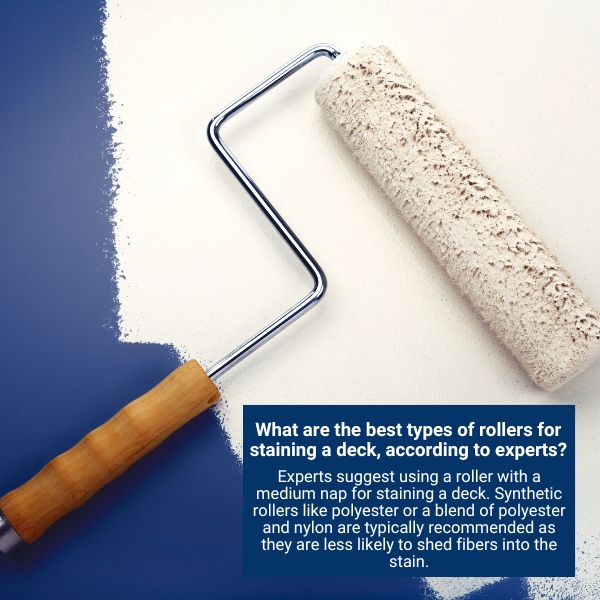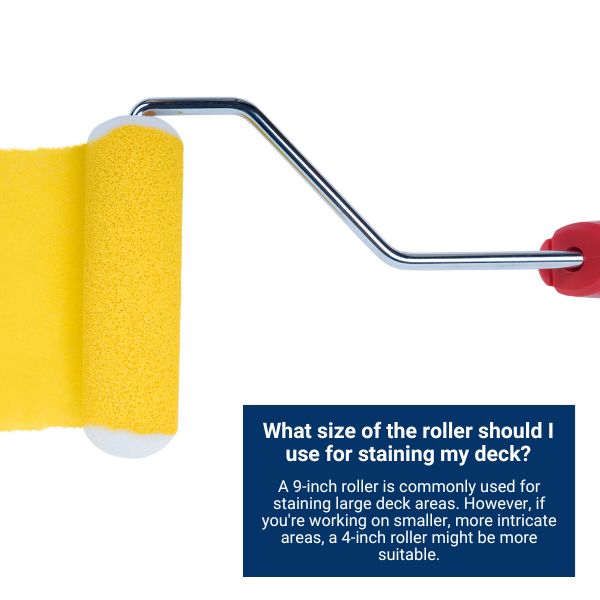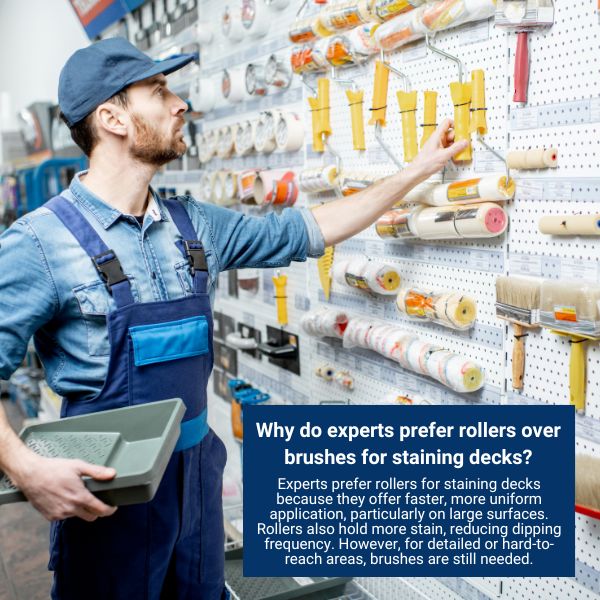Staining is a crucial task when it comes to enhancing and preserving the beauty of your outdoor deck. However, achieving a smooth and even finish on the deck can be a challenging task. So, what’s the secret ingredient to mastering this task? The answer lies in the tools you use, specifically the roller.
A deck staining project’s success hinges significantly on this often-underestimated tool. The right roller can make the difference between a streaky, uneven finish and a professional, flawless one.
However, with a myriad of choices on the market, selecting the best roller for deck staining can be daunting. Now, You might find yourself asking, “Which roller should I choose for the most effective deck staining?”
Experts suggest that high-density foam rollers are the best deck staining rollers. They provide even coverage of the stain without leaving behind any lint or fibers that may embed in the wood. In addition, they are easy to clean and don’t shed, unlike traditional rollers, making them an excellent choice for DIYers and professionals alike.
The material of the deck roller is one of many aspects to look at when choosing the best roller. The size, accessories, and handle quality also matter. Therefore, today I will explore the different types of rollers available on the market, how to choose the right roller size, and other essential tips and tricks to select the best tool for a professional finish.
So, whether you’re a seasoned painter or a newbie DIYer, keep reading to learn more and transform your deck into a stunning outdoor oasis.
What Are The Best Rollers For Deck Staining?
Staining your deck is an essential task that helps maintain its beauty while protecting it from harsh weather conditions. A critical part of this process is choosing the right tool for the job. In this case, I am talking about rollers.
When it comes to staining your deck, not just any roller will do. The choice of roller can significantly affect the quality and ease of your staining project. It depends on various factors, such as the type of stain you’re using, the size of your deck, and your personal preferences.
Let’s dive into the world of rollers and explore the best options for staining your deck.

Type Of Roller:
The roller’s foam material is crucial for spotless deck staining. Therefore, choosing a suitable material with high absorbance and lasting quality is essential. Foam rollers usually have higher recommendations for deck staining, specifically for large surfaces. They are highly absorbent and allow smooth application without brush or roller marks. However, I would never recommend using foam rollers with water-based topcoats as it can cause bubbles and aeration.
Choosing The Right Roller
When it comes to staining decks, experts generally recommend a medium nap roller. The “nap” or pile of a roller refers to the thickness of the fabric cover. Medium nap rollers are perfect for deck staining because they hold a good amount of stain and can manage the texture of the wood effectively.
The material of the roller is also important. Synthetic rollers, such as polyester or a blend of polyester and nylon, are commonly recommended. They are less likely to shed fibers into the stain, ensuring a cleaner finish.
Top Roller Choices For Deck Staining
- Wooster Brush: Wooster is a well-respected brand among professionals, and their brushes and rollers are known for their high quality. The Wooster Brush R291-9 Lambswool 100 Roller Cover with a medium nap is an excellent choice for staining a deck. It holds a lot of stain and applies it evenly.
- Purdy Roller Covers: Purdy is another trusted brand in the painting industry. Their rollers are durable and provide a smooth, lint-free finish. The Purdy 144688094 Contractor 1st Series Polyester Roller Cover is a great option for deck staining, offering excellent paint pickup and release for a uniform application.
Keys Factors In Selecting The Perfect Deck Roller
To understand the deck staining process, I have curated a list of essential factors that will help you select the perfect roller for your task.
1. Type Of Stain: Water-Based vs. Oil-Based
The type of stain you’re using is an essential factor to consider when choosing a roller. Water-based paints are thinner than oil-based stains and require a roller with a lower nap length oil-based stains are thicker and need a higher nap length to ensure proper application. Besides, foam rollers are also not suitable for water-based paints. Therefore, a Nano Flock roller would be better for applying a thin water-based topcoat. Furthermore, you can also pick from other rollers like Velour or Micro-Fiber according to the specific finish you’re using.
2. Understanding Nap Length:
The nap length of a roller plays a vital role in determining how much stain the roller can hold and how evenly it can be distributed. For decks, a roller with a long nap length (usually between 3/8 inch to 1/2 inch) is best because it can hold more stain and provide even coverage. A shorter roller may not have enough pigment, while a longer nap can result in excess dye and drips. So, choosing the right nap length is crucial for perfect finishing.
3. Choosing The Right Roller Size For Your Deck
A larger roller size can cover more surface area in less time but may not be suitable for intricate or tight spaces. On the other hand, a smaller roller size may be more appropriate for hard-to-reach areas but may require more time and effort to cover larger areas. Therefore, you must choose the roller considering the deck’s size, the layout’s complexity, and the problematic areas of your deck.

4. Comfort And Grip: Key To Efficient Staining
Wood staining roller is a time taking task that needs long-term effort. Thus, you need to make sure that your roller has a firm grip and that you can operate it with comfort. It’s a crucial aspect of easy application to avoid hand strains. So always look for solid handles with firm grips to stay comfortable throughout.
5. Investing In Quality: The Importance Of A Durable Roller
Another factor to consider is the quality of the roller. Selecting a high-quality roller is crucial to achieving better outcomes. Try to find rollers made with durable materials. When selecting a roller, prioritize those constructed with metal handles and good quality foam and fibers with robust construction that can endure regular usage.
6. Smooth vs. Textured Rollers: What’s Best For Your Stain Type
The stain outcome is also dependent on the surface of the roller. If you want an even finish, getting a smooth roller is recommended. On the other hand, if your deck has rough or textured wood, a textured roller is ideal. Because it will help the stain penetrate deeper into the wood’s surface.
7. Deck Color Considerations In Roller Selection
When buying any tool for deck staining, there are several factors to look for professional end results. Deck stain is another considerable aspect of choosing the best roller for wooden deck staining. Since a thicker stain layer can change the stain color, you must pick a foam roller with a shorter nap length using a lighter stain and vice versa. It will help you avoid double coats and create a finished stained deck.

8. Deck Material: Matching The Roller To Your Wood Type
When it comes to staining, the type of wood your deck is made of can significantly influence the kind of roller you should choose. Different woods have unique characteristics, and using the right roller can ensure the stain is applied evenly and effectively.
A smooth roller is usually the best choice for softer, smoother woods like pine or birch. These woods have a tighter grain and don’t require as much stain to penetrate the surface, so that a smooth roller can provide an even, clean finish.
On the other hand, if your deck is made of rougher, more porous woods like cedar or redwood, a textured roller would be more suitable. These woods have a more open grain that can absorb more stain, and a textured roller can help ensure the stain penetrates deeply into the wood for long-lasting protection.
9. Price: Balancing Affordability And Quality
Besides quality and texture, price is important when purchasing a wood staining roller. When purchasing a roller for your deck staining project, finding a balance between affordability and quality is key. Roller prices can range widely, from as low as $4 for basic models to over $20 for professional-grade options.
While budget rollers ($4-$6) may seem appealing, they often lack durability and evenness of application, potentially leading to subpar results. Conversely, high-end rollers ($15-$20 and above) offer exceptional durability and even application, but their high cost may not always equate to better results, especially for smaller or simpler projects. Mid-range options ($8-$14) often strike a good balance, offering enhanced durability and application without the high cost of professional-grade rollers.
When To Replace Your Roller: Tips For Optimal Staining
One sign is when the roller begins to shed fibers. If you notice bits of the roller material left behind on your deck, it’s a surefire sign that your roller is past its prime. Not only can these fibers get stuck in your stain, marring the smooth finish, but shedding also indicates that the roller material is breaking down and can’t distribute the stain as effectively.

Another sign is an uneven stain application. A good roller will distribute the stain uniformly, ensuring every part of your deck gets an equal amount of stain. But as a roller age, it might not hold or release the stain as well, leading to patchy or uneven staining. If you’re finding that you need to go over areas multiple times to get even coverage, your roller could be the culprit.
Also Read: Deck Nail Vs Screw, Which Is The Best? When And Where To Use It?
Finally, if your roller becomes difficult to manage, it might be time for a replacement. Over time, the roller might become saturated with stain, causing it to become heavy and hard to maneuver. This could lead to hand strain and fatigue, making your staining project more difficult than it needs to be.
Conclusion:
In conclusion, choosing the right roller for the best outcomes is crucial. The deck staining process isn’t always dependent on the stain, but the material, nap length, and roller size also matter. Besides, not every roller is for you. Therefore you need to check your need before investing in a good roller. Moreover, it’s better to buy rollers in two different sizes to cover more wide areas quickly and crevices neatly.

